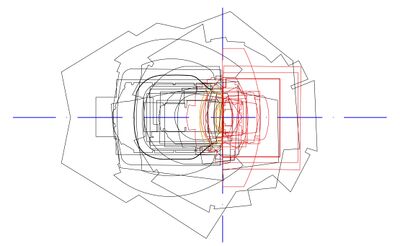The Zero Point is a reference point on the stage, from which measurements can be taken in a standard way. In a proscenium theatre, the zero point is usually the place where the centre line of the stage and auditorium meets the line of the curtain.
The zero point (Q3660) is a mark in the stage, serving as a reference point for all departments in the theatre. In proscenium theatres, the centre line runs from upstage to downstage, defining a mirror-symmetry about a central axis for both the stage and the auditorium. At right angles to the centre line is the setting line, which is usually defined by the back face of the proscenium arch, or the line slightly upstage where the curtain or ‘house tabs’ fall, or where the safety curtain (the ‘iron’) meets the stage when it is lowered. The setting line is therefore sometimes called the ‘plaster line’ (where the decorative plaster of the auditorium ends), ‘curtain line’ or ‘iron line’. Where the setting line and the centre line meet is the zero point – also known as the centre point or setting point.
The zero point is an essential tool in planning productions. It gives a reference point for placing scenery, and lighting, sound and other technical equipment. The zero point, with the centre line and setting line, are marked on plans, so all departments share a common reference, to avoid errors and misunderstandings. When placing scenery or equipment on the stage, measurements can be made from the zero point, based on the measurements shown on the plan. The zero point is therefore a vital tool in translating from a drawing of the space to the actual space.
The zero point is particularly important in touring. Technicians and designers working in their own theatre get to know what will fit, and what the most important measurements are, but for a production that has to fit in many different theatres, each different in size and shape, having a system for making measurements is vital. Designers, technical and production managers can plan their touring production by overlaying a drawing of the set onto a drawing of each venue, aligning the zero points, to see if the scenery will fit into each theatre, and make any adjustments required.
In the mid 20th century the development of large, complex and three-dimensional scenery made standardising reference systems essential. In particular, the growing complexity of lighting, sound and video systems, which require very precise positioning to work as intended, has greatly increased the need for detailed planning of how everything will fit together in the space. A standard system of reference points is fundamental to this work.
The zero point is not just a conceptual point, it is often physically marked on the stage. This is usually done with a small brass plate embedded into the stage surface, with the zero point engraved into it. In the Netherlands the zero point is given the name Koperen Kees, suggesting the mark is made of copper, though it is usually made of brass. It can be found as a mark in almost every theatre, and owes its name to Kees van der Wilk who carried out the first technical inventories. Nowadays the technical inventories and the digital drawings are managed by the foundation ‘Stichting Teken’, founded by Bert Middelweerd. He has been placing ‘Bronzen Bert’ in theatres since the 1990s.
The zero point, used by the scenic and technical departments, is not the only referencing system used on the stage. Lighting designers will often divide the stage space into areas, each lit separately to give an ‘area cover’. They sometimes mark these areas out temporarily in chalk or tape while focusing. In repertoire theatres, grids may be marked on a stage cloth to help focus lights, when the actual piece of scenery to be lit is not on stage. Choreographers also may mark the front edge of the stage with numbers, to help dancers locate themselves.
The concept of the zero point, defined by a presumed centre line and proscenium line, is particularly related to proscenium arch theatres. The increase in theatres that are not proscenium stages has brought the zero point into question, both practically and conceptually. For a theatre in the round, or a thrust stage, or a traverse with audience on opposite sides, where is the universally understood reference point? In a proscenium arch, ‘downstage centre’, where the zero point is, is the most powerful position for an actor to address the audience, but in other types of spaces, where is that position? The zero point is a practical method to eliminate errors and failures of communication, but it also reminds us that proxemics – the way that people relate to each other spatially – is fundamental to the theatre experience.
